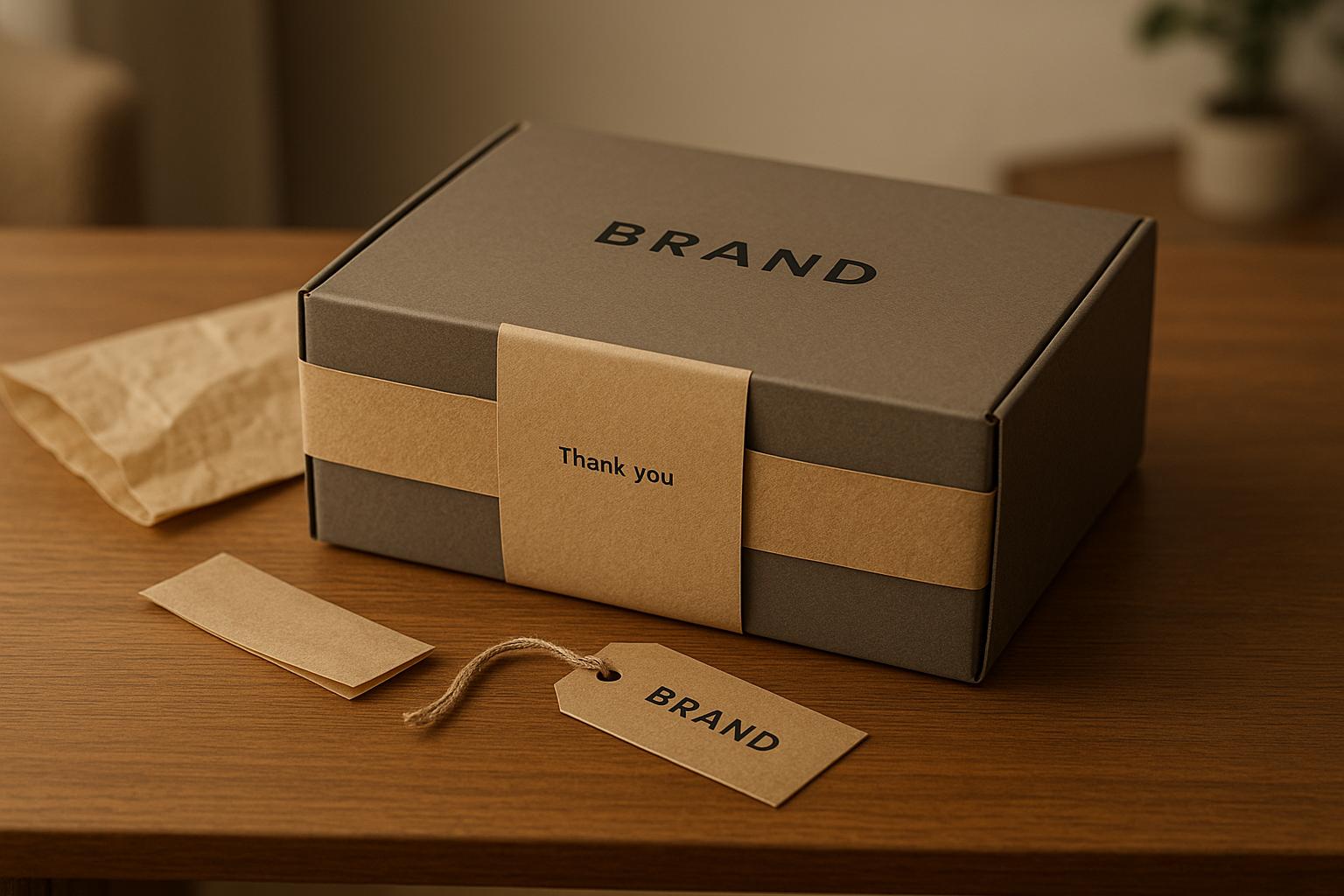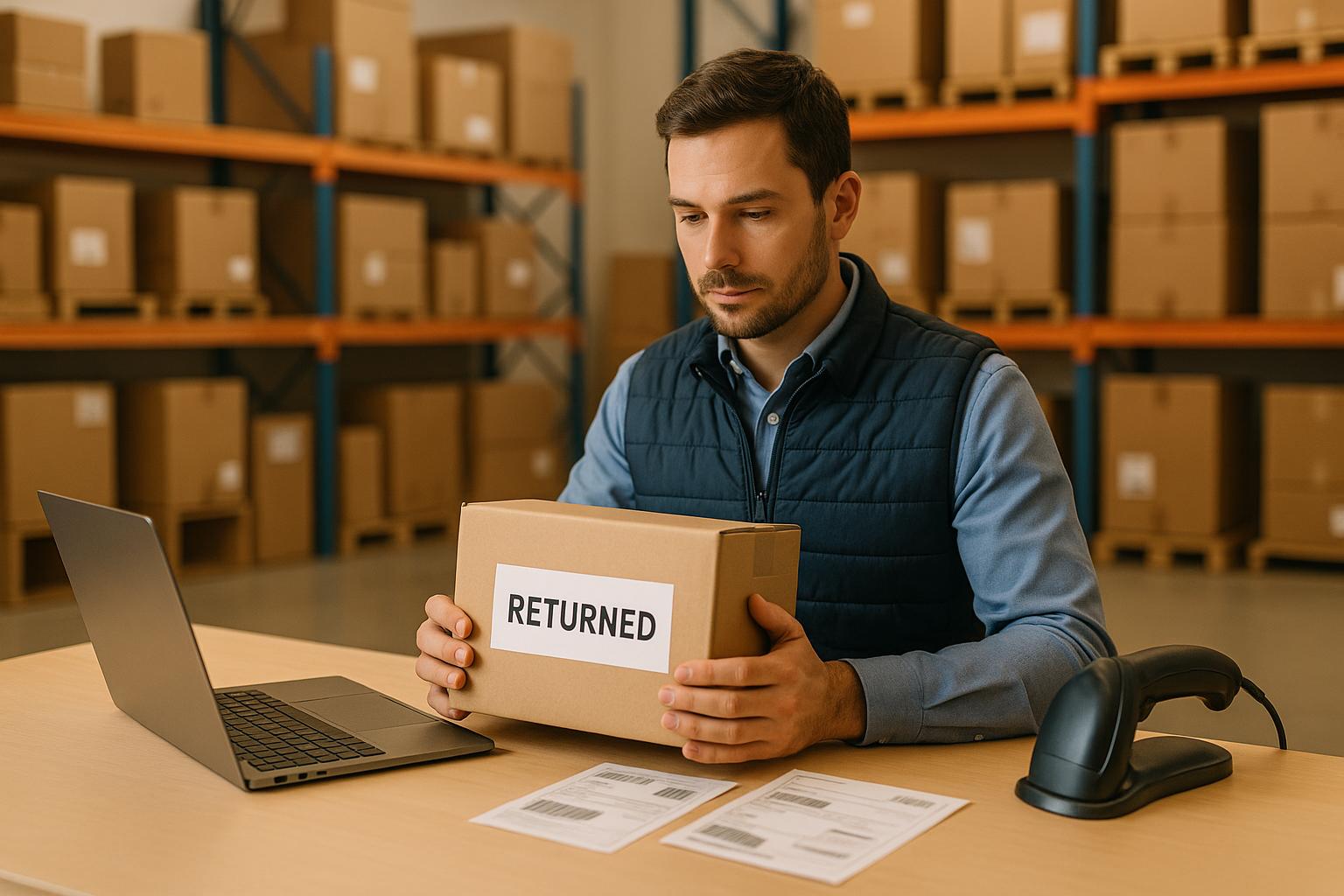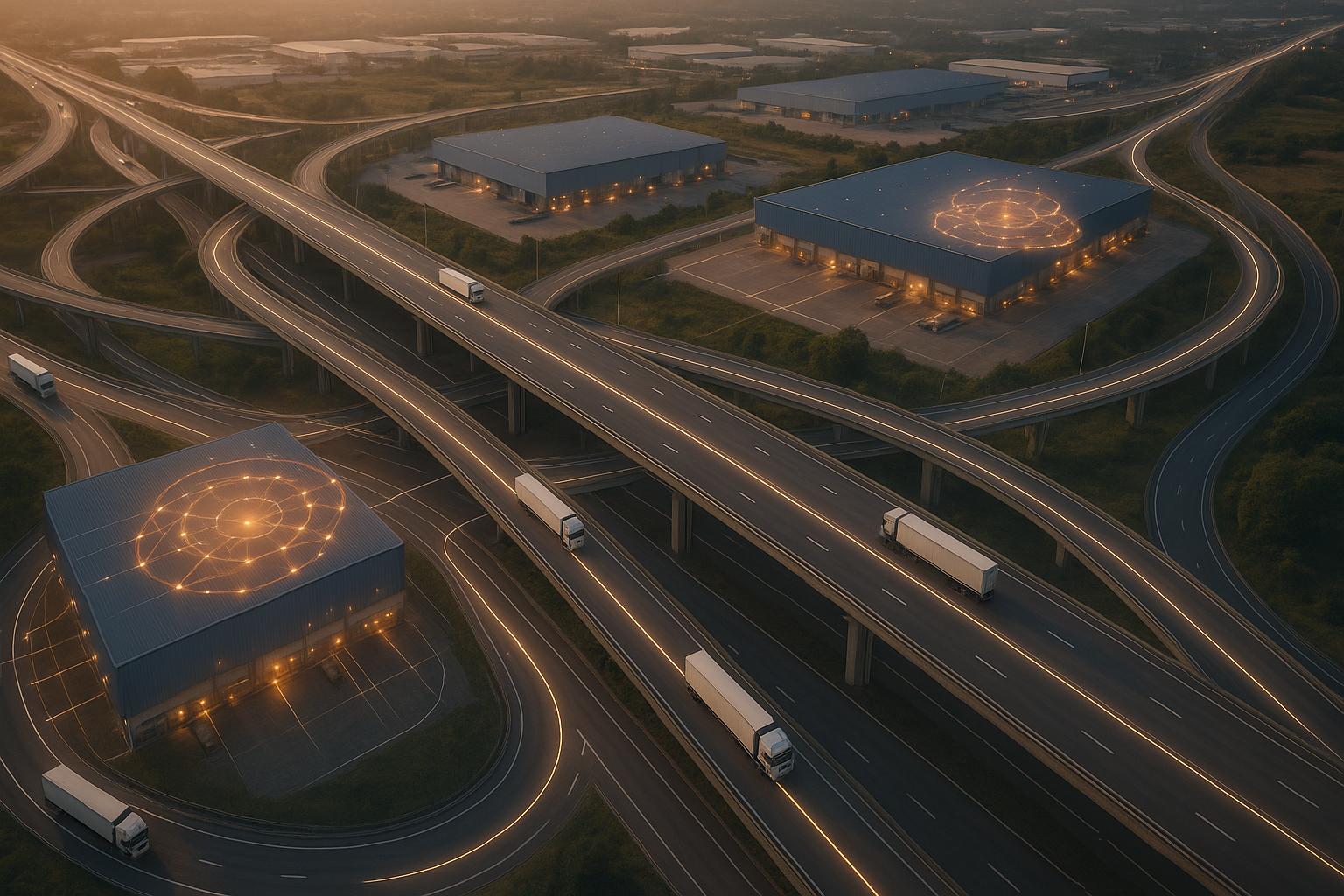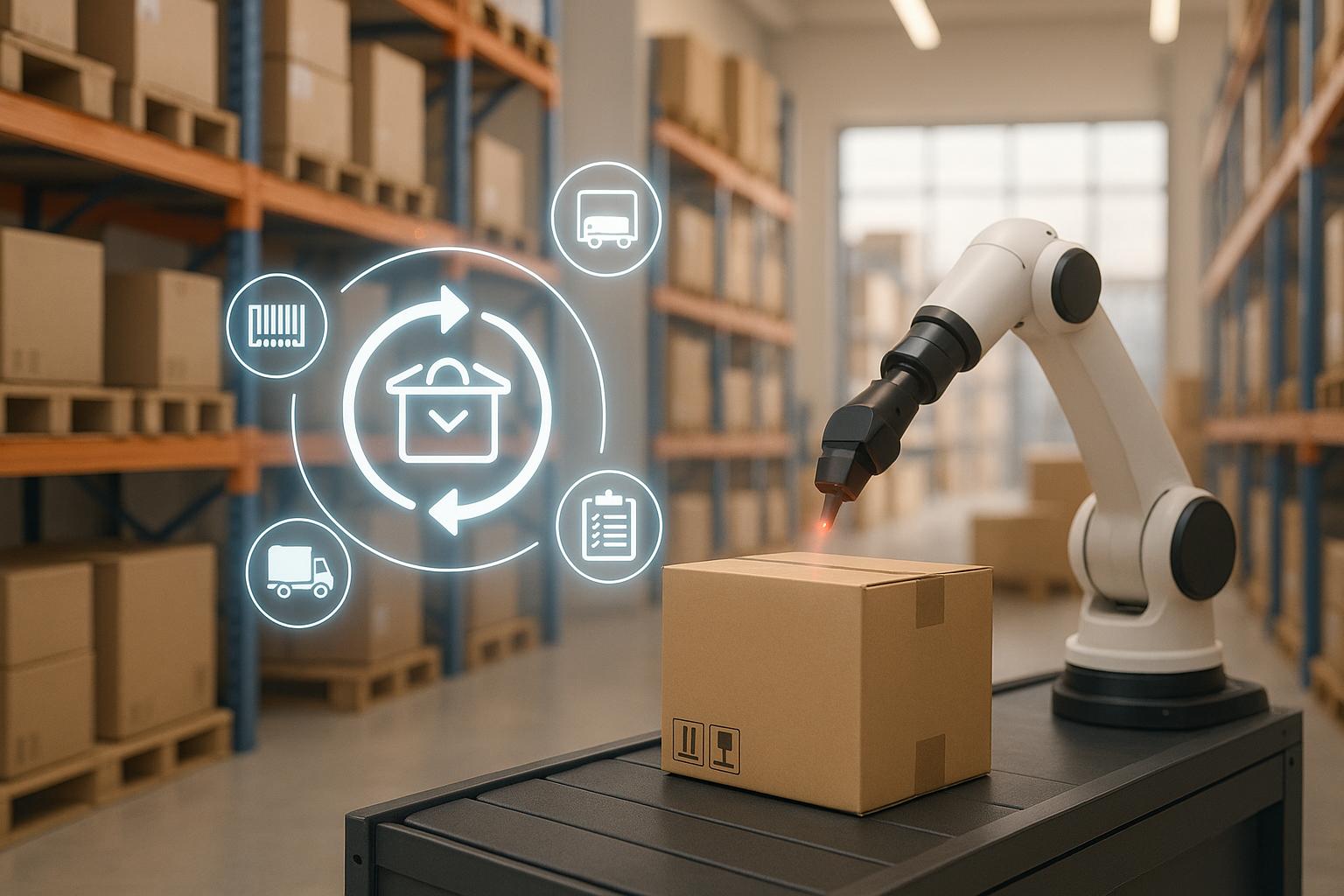Premium Packaging for E-commerce Brands

Premium packaging is more than just protecting products - it's about creating memorable experiences that boost customer loyalty and drive growth. For U.S. e-commerce brands, premium packaging combines quality materials, creative designs, and functional features to deliver value while aligning with modern consumer preferences. Here's why it matters and how it can transform your brand:
- First Impressions Matter: Packaging is often the first physical interaction customers have with your brand. Over 60% of online shoppers say a high-quality unboxing experience increases the likelihood of repeat purchases.
- Eco-Friendly is Expected: 70% of U.S. shoppers prefer packaging that prioritizes sustainability, like recyclable or compostable materials.
- Unboxing Drives Engagement: Thoughtful design, personalization (e.g., thank-you notes), and interactive elements (e.g., QR codes) encourage customers to share their experiences online, amplifying your brand's reach.
- Trends to Watch: Minimalist designs, sustainable materials, and functional features like resealable closures are shaping the future of premium packaging.
- Logistics and Scalability: Partnering with reliable 3PL providers ensures packaging quality at scale, with services like kitting, white glove handling, and inventory management.
Whether you're a luxury brand or a growing e-commerce business, premium packaging can reduce costs, improve customer satisfaction, and set you apart in a competitive market. The key is balancing aesthetics, functionality, and sustainability while maintaining efficient logistics.
Ecommerce Product Packaging Design And Unboxing Tips
Key Elements of Premium Packaging Solutions
Creating premium packaging is about more than just protecting your products - it's a chance to elevate your brand and leave a lasting impression on customers. The right combination of materials, design, and functionality can make all the difference.
Materials and Eco-Friendly Options
The backbone of any premium packaging solution lies in the materials you choose. For high-value products, rigid boxes are a go-to option. They offer a luxurious feel and robust protection, with costs ranging from $2.00 to $5.00 per unit.
If you're looking for something that balances durability and cost, corrugated mailers are a smart choice. Lightweight and sturdy, they cost between $0.50 and $2.00 per unit and support custom branding. Another versatile option is paperboard cartons, especially those made from recycled or unbleached materials, which combine sustainability with an attractive appearance.
Eco-conscious consumers increasingly expect packaging that aligns with their values. Options like recyclable cardboard boxes, compostable poly mailers, and biodegradable fillers are great for reducing environmental impact. Companies such as EcoPackables and Arka specialize in 100% recycled kraft mailers and compostable packaging solutions, making it easier to meet these expectations.
Rigid Boxes
- Sustainability: Low–Medium
- Protection Level: High
- Customization Options: High
- Cost Range: $2.00–$5.00
Corrugated Mailers
- Sustainability: High
- Protection Level: Medium–High
- Customization Options: Medium–High
- Cost Range: $0.50–$2.00
Compostable Mailers
- Sustainability: High
- Protection Level: Medium
- Customization Options: Medium
- Cost Range: $0.75–$2.50
Recycled Paperboard
- Sustainability: High
- Protection Level: Medium
- Customization Options: High
- Cost Range: $0.60–$2.00
When selecting materials, consider your brand's values and budget. Keep in mind that eco-friendly options may come with higher upfront costs or slightly lower durability compared to traditional plastics. The key is finding the right balance for your product type and shipping needs.
Design and Brand Elements
Material selection is just the beginning - design is where your packaging truly comes to life.
A well-designed package tells your brand's story and creates a memorable customer experience. Structural elements like reinforced corners, custom inserts, and double-walled construction keep products safe, while design features such as custom printing, embossing, and inside-box artwork add a personal touch. These details can turn unboxing into a shareable moment, boosting your brand's visibility on social media.
Custom printing is a powerful way to showcase your logo, brand colors, and messaging. Techniques like embossing, debossing, and foil stamping add texture and visual appeal, creating a premium look and feel. Inserts can serve both protective and promotional purposes, offering space for thank-you notes, care instructions, or even discount codes.
For example, Zenpack has helped clients use specialty papers and satin-touch finishes to craft packaging that stands out. These thoughtful combinations of colors, finishes, and structural designs have earned positive customer feedback and driven social media engagement.
Another trend gaining traction is ships-in-own-container (SIOC) packaging. Popular among e-commerce brands, this approach eliminates the need for extra shipping boxes, cutting costs while maintaining product protection and brand visibility during delivery.
Practical and Functional Features
While aesthetics are important, functionality is what ensures a smooth experience for both customers and fulfillment teams. Premium packaging should be easy to use and practical.
Features like tear strips make it simple for customers to open packages without scissors or knives, while tape-free closures speed up the packing process and keep packages secure during transit. Reusable designs not only enhance sustainability but also encourage repeat use, reinforcing your brand's eco-friendly image.
Clear labeling and intuitive opening mechanisms improve usability, while options like resealable closures or tamper-evident seals provide added convenience and security. These elements can also streamline operations, particularly when working with third-party logistics (3PL) providers. For instance, easy-to-assemble packaging reduces labor time and minimizes errors, which becomes especially valuable when partnering with companies like JIT Transportation for scalable services such as pick & pack, kitting, and assembly.
The global e-commerce packaging market is expected to hit $61.55 billion by 2027, driven by the need for solutions that combine premium design with practical functionality. Brands that strike this balance are well-positioned to grow while delivering the high-quality experiences that foster customer loyalty.
Finally, quality control is critical. Regular testing ensures your packaging can withstand the rigors of shipping, protecting both the product and the premium experience your brand promises to deliver.
Improving Customer Experience with Premium Packaging
Premium packaging turns the delivery process into more than just a transaction - it becomes a memorable brand moment that builds loyalty and encourages customers to spread the word.
Creating Memorable Unboxing Experiences
The unboxing moment is your brand’s chance to leave a lasting impression. A visually appealing and tactile package creates excitement before the product is even revealed. Thoughtful design choices here can do wonders for customer engagement and even spark social media buzz.
Take Glossier, for example. In 2023, their minimalist packaging approach led to a 20% increase in repeat purchases, fueled by thousands of unboxing posts shared online. This shows that even simple, consistent designs can resonate strongly with customers.
Adding interactive elements is another way to elevate the experience. In 2024, L’Oréal incorporated QR codes into their packaging, providing access to tutorials and product details. The result? A 15% boost in customer engagement and a 10% drop in customer service inquiries.
Subscription boxes are masters of creating unboxing anticipation. By layering branded tissue paper, custom stickers, and carefully arranged products, they make every step of the opening process feel special. These small touches turn unboxing into a shareable moment, perfect for social media.
According to a Dotcom Distribution study, 40% of consumers are more likely to make repeat purchases from brands with premium packaging, and 39% say they’d share a unique unboxing experience online. These moments lay the groundwork for deeper personalization, which further strengthens customer relationships.
Personalization and Custom Details
Adding personal touches to your packaging can make customers feel valued in a way that standard packaging just can’t. Whether it’s a handwritten thank-you note, a custom message, or a tailored insert, these details show that your brand sees its customers as individuals, not just order numbers.
Branded tissue paper, custom stickers, or even product samples can elevate the experience. Some brands go a step further by including discount codes for future purchases or QR codes that link to exclusive content, blending personalization with incentives for repeat business.
For example, a luxury skincare brand might include a handwritten note explaining the benefits of the product, while a tech company could use QR codes to share setup tutorials or hidden features. The key is to make these touches feel genuine, not forced.
Seasonal or limited-edition packaging also adds a layer of exclusivity that customers love. Whether it’s a holiday-themed box or a special event design, these unique touches encourage customers to share their purchases online, potentially attracting new buyers through social media exposure.
Quality Control and Product Protection
While great design and personalization grab attention, ensuring the integrity of your packaging is just as important. High-quality packaging materials and rigorous quality control are essential for protecting products during shipping and maintaining customer trust.
Durable materials like corrugated structures, reinforced liners, and shock-absorbing inserts can handle the stresses of transit. Testing your packaging under real-world shipping conditions helps identify and fix weak points before they lead to customer complaints.
"Their on-time performance, ability to handle last-minute requests, and expertise in material handling are game-changers for us." - Curtis Martin, Senior Operations Manager, Synnex
Partnering with experienced logistics providers is crucial, especially as your packaging operations grow. Companies like JIT Transportation specialize in services like white glove handling and precise material management, ensuring premium packaging is assembled consistently, even at scale. Their expertise in pick-and-pack operations ensures your packaging maintains its quality, no matter the volume.
Zenpack has reported that clients see lower damage rates and higher customer satisfaction after switching to premium packaging solutions. Some brands have even reduced packaging costs by 20% while earning positive feedback on social media. These results highlight how investing in quality control can improve both customer experience and operational efficiency.
Collecting feedback and running regular tests ensures your packaging evolves with your customers’ needs. Reviews, return rates, and social media mentions offer valuable insights into how your packaging performs in the real world. By using this data, you can fine-tune your approach and keep exceeding customer expectations as your business grows.
sbb-itb-eafa320
Logistics and Fulfillment for Premium Packaging
Premium packaging isn't just about aesthetics - it's about ensuring that every detail, from the materials to the final delivery, reflects the brand's quality. To achieve this, logistics must account for delicate materials, intricate assembly, and precise fulfillment. The right fulfillment partner plays a critical role, acting as an extension of your brand to maintain the appeal and integrity of every package, from warehouse to doorstep.
How 3PL Providers Support Premium Packaging
Advanced third-party logistics (3PL) providers are key to maintaining the quality of premium packaging, even at scale. They offer services like pick & pack, kitting & assembly, and white glove handling, ensuring that fragile and custom elements remain flawless throughout the fulfillment process.
White glove handling is particularly important for protecting high-value and delicate items, such as luxury cosmetics, electronics, or artisan goods. This service ensures that products arrive in perfect condition, safeguarding the premium experience your customers expect.
Take JIT Transportation as an example. They provide a comprehensive suite of services - including pick & pack, kitting & assembly, testing, and white glove handling - through a nationwide network. Their scalable infrastructure and advanced technology ensure reliable fulfillment, even during peak seasons, without compromising on quality.
"JIT sets the bar high in logistics. Their on-time performance, ability to handle last-minute requests, and expertise in material handling are game-changers for us. Add to that their competitive pricing and professional service, and it's clear why they're one of our most valued partners." - Curtis Martin, Senior Operations Manager, Synnex
Modern 3PL providers also integrate seamlessly with e-commerce platforms. This integration allows for real-time inventory tracking, coordination with multiple suppliers, and efficient management of complex packaging requirements, ensuring smooth operations without the need for constant manual oversight.
Managing Packaging Inventory
Managing packaging inventory efficiently is essential for premium packaging. A just-in-time (JIT) inventory approach can help reduce storage costs while maintaining flexibility. Instead of stockpiling costly custom boxes, branded inserts, or specialty materials, brands can coordinate with suppliers and 3PL providers to receive packaging components as needed.
This strategy offers several advantages. High-end materials often have a limited shelf life or require significant storage space. By using JIT delivery, brands minimize the risk of materials becoming outdated or damaged in storage, while also avoiding the financial strain of tying up capital in excess inventory.
However, successful JIT management relies on strong supplier relationships and accurate demand forecasting. Brands should use systems that predict packaging needs based on sales trends, seasonal shifts, and promotional activities. At the same time, 3PL providers must have the infrastructure to handle frequent, smaller shipments and integrate them smoothly into fulfillment operations.
To mitigate risks, maintaining a small safety stock - about 15-30% above forecasted demand - can prevent stockouts. This is especially useful for core packaging materials, while specialty items like seasonal designs or limited-edition packaging can be managed through JIT delivery.
Working with 3PL providers that offer vendor-managed inventory (VMI) services can further simplify the process. These providers monitor packaging usage patterns and coordinate replenishment automatically, reducing the administrative workload for brands while ensuring consistent availability.
Scaling Packaging Solutions for Business Growth
As businesses grow, scaling premium packaging solutions becomes a more complex challenge. Growth brings increased order volumes, which can strain logistics, inventory management, and quality control.
Maintaining quality consistency is the first hurdle. Suppliers must scale production without compromising the visual appeal or protective qualities that define premium packaging. This requires clear quality standards and partnerships with suppliers who have a proven ability to deliver at higher volumes.
Logistics capacity must also expand. A reliable 3PL provider needs the warehouse space, trained staff, and shipping capabilities to handle increased demand while maintaining the careful handling that premium products require. They should also have contingency plans for peak seasons or sudden demand spikes.
Inventory management becomes more complex as brands deal with multiple SKUs, packaging variations, and seasonal requirements. Poor forecasting can lead to stockouts, which hurt customer satisfaction, or overstocking, which ties up capital and space.
JIT Transportation is a great example of a provider that addresses these challenges. Their flexible network adapts to fluctuating demand, with extensive carrier options and strategically located warehouses enabling cost-effective fulfillment. Their scalable infrastructure ensures that growing brands can meet increasing demands without outgrowing their logistics capabilities.
"JIT isn't just another trucking company - they are true logistics innovators. Their ability to anticipate industry shifts, build long-term relationships, and deliver tailored, high-impact solutions sets them apart as a leader in the field. We trust JIT to move our business forward." - Ron Okamoto, Nippon Express USA, INC.
Planning for seasonal peaks is another critical aspect of scaling. Brands should analyze historical sales data to identify peak periods and forecast demand 8-12 weeks in advance. Close communication with packaging suppliers and 3PL providers ensures that inventory and fulfillment capacity are ready for high-demand periods, such as the holidays or back-to-school season.
To avoid disruptions, establish backup suppliers and maintain regular communication with your 3PL provider to adjust forecasts as needed. This proactive approach ensures that the premium experience is preserved, reinforcing customer loyalty and maintaining the high standards of your brand throughout the fulfillment process.
Premium Packaging Options and Features Comparison
When selecting premium packaging, it's crucial to weigh factors like durability, environmental impact, cost, and the impression it leaves on your customers. Each material and service option offers distinct advantages, enabling e-commerce brands to align their packaging choices with their budgets, values, and customer expectations.
Material and Design Comparison
Premium packaging materials vary widely in functionality, cost, and brand appeal. Here's a closer look at the three most popular options:
Rigid boxes stand out for their durability and upscale branding potential. These are perfect for luxury products, electronics, or premium subscription services. However, their premium quality comes with a higher price tag, typically ranging from $2.50 to $7.00 per unit, depending on size and customization.
Corrugated mailers strike a balance between affordability and functionality. Priced between $0.50 and $2.00 per unit, they offer moderate durability and excellent recyclability. Their versatility makes them ideal for general e-commerce, books, and apparel. Customization options, such as printing and branded inserts, can enhance the unboxing experience without breaking the bank.
Eco-friendly materials, like compostable mailers or recycled kraft options, cater to sustainability-conscious shoppers. Costing between $0.75 and $2.50 per unit, they resonate with the 67% of U.S. consumers who prioritize recyclable packaging during purchases. Additionally, brands using eco-friendly packaging have seen up to a 25% boost in repeat purchases.
Here’s a quick comparison of these materials:
Rigid Boxes
- Durability: High
- Environmental Impact: Moderate (better with recycled materials)
- Cost Range: $2.50–$7.00
- Visual Impact: Excellent
- Best Use Cases: Luxury goods, electronics, premium subscriptions
Corrugated Mailers
- Durability: Medium
- Environmental Impact: High (highly recyclable)
- Cost Range: $0.50–$2.00
- Visual Impact: Good
- Best Use Cases: General e-commerce, books, apparel
Eco-Friendly Mailers
- Durability: Medium
- Environmental Impact: Excellent
- Cost Range: $0.75–$2.50
- Visual Impact: Good
- Best Use Cases: Sustainable brands, health products, cosmetics
Each material can be elevated through thoughtful design elements like custom printing, branded inserts, or refined finishes. While rigid boxes exude luxury, corrugated and eco-friendly mailers can also deliver a polished, memorable experience with the right design touches. These choices not only enhance brand perception but also integrate seamlessly into logistics workflows.
Value-Added Logistics Services Benefits
Premium packaging isn’t just about materials - it’s also about how orders are prepared and delivered. Value-added logistics services play a key role in ensuring that the packaging lives up to its promise.
Kitting and assembly services are essential for multi-item orders. By grouping products into cohesive packages that reflect brand standards, these services enhance presentation and reduce fulfillment errors. This typically costs an additional $0.50 to $2.00 per order, but the benefits - consistent presentation and fewer mistakes - are well worth it.
Pick and pack services focus on precision and careful handling during fulfillment. This ensures that premium packaging remains intact and items arrive as intended, maintaining the quality that customers expect from high-end brands.
White glove handling takes logistics care to the next level. Designed for fragile or high-value items, this service minimizes the risk of damage and ensures a flawless unboxing experience. While it comes at a higher cost, the added protection and attention to detail can significantly enhance customer satisfaction.
Here’s a breakdown of these services:
Kitting & Assembly
- Efficiency Impact: High
- Damage Reduction: Medium
- Customer Satisfaction: High
- Typical Cost Addition: $0.50–$2.00 per order
- Primary Benefits: Consistent presentation, reduced errors
Pick & Pack
- Efficiency Impact: High
- Damage Reduction: Medium
- Customer Satisfaction: High
- Typical Cost Addition: Varies by complexity
- Primary Benefits: Order accuracy and careful handling
White Glove Handling
- Efficiency Impact: Moderate
- Damage Reduction: Very High
- Customer Satisfaction: Very High
- Typical Cost Addition: Premium pricing
- Primary Benefits: Maximum protection and a luxury experience
As businesses grow, these logistics services become increasingly important. Managing 100 orders a month is vastly different from handling 10,000, and the right logistics partner can scale processes while maintaining the attention to detail that defines premium packaging.
Investing in top-quality materials and logistics services often pays dividends, reducing returns, improving customer satisfaction, and driving repeat purchases. In fact, well-crafted premium packaging can even generate buzz, with 40% of online shoppers saying branded packaging makes them more likely to recommend a product to friends.
Conclusion and Key Takeaways
For e-commerce brands, premium packaging has evolved from a nice-to-have into an essential part of the business strategy. The numbers don’t lie: 72% of American consumers say packaging design influences their purchasing decisions, and 61% are more likely to become repeat customers when brands use premium packaging. These aren’t just statistics - they’re direct pathways to stronger customer loyalty and higher sales.
Investing in premium packaging delivers benefits on multiple levels. It reduces product damage, lowers return rates, and boosts customer satisfaction. Beyond practicality, it creates memorable unboxing experiences that customers love to share. In fact, over 50% of online shoppers say branded packaging makes them more excited about their purchase and more likely to post about it on social media. That’s organic marketing you can’t afford to miss.
Sustainability is no longer optional - it’s expected. With 74% of consumers willing to pay more for products with sustainable packaging, using eco-friendly materials is now table stakes. But the real winners are brands that combine environmental responsibility with sleek design and functionality. When paired with efficient logistics, this approach not only meets consumer expectations but also strengthens your brand’s position in the market.
Speaking of logistics, scaling premium packaging requires expertise. Partnering with experienced 3PL providers ensures that even as order volumes grow, quality remains consistent. From managing custom inserts to handling reusable designs, reliable logistics make premium packaging scalable and stress-free.
Personalization is another game-changer. Small touches like custom inserts, handwritten thank-you notes, or reusable packaging create emotional connections that turn one-time buyers into loyal advocates. These thoughtful details - combined with sustainability, functionality, and efficient logistics - form the backbone of a successful premium packaging strategy.
For e-commerce brands, the question isn’t whether premium packaging adds value - it’s how quickly it can be implemented. Start by choosing sustainable materials that align with your brand values. Work with logistics partners who understand the complexities of premium fulfillment. And most importantly, keep the customer experience at the heart of every decision. From materials to delivery, every element of premium packaging contributes to a cohesive brand story. Brands that prioritize and perfect this today will set the standard in tomorrow’s marketplace.
FAQs
How can e-commerce brands balance sustainability with the cost of premium packaging?
Balancing environmental responsibility with the expense of premium packaging takes careful planning and a focus on long-term benefits. For e-commerce brands, a good starting point is choosing materials like recycled cardboard or biodegradable plastics. These options can help reduce environmental impact while still delivering on quality. Plus, embracing simpler designs can cut material costs without losing that premium feel.
Another key factor is the customer experience. Sustainable packaging doesn’t just protect products - it can also elevate how customers view your brand and build loyalty. While reusable or durable packaging might come with a higher initial price tag, it can pay off in the long run by cutting down on waste and encouraging repeat purchases. Partnering with the right suppliers and streamlining logistics can help brands strike that important balance between cost efficiency and quality.
How does personalization enhance the customer unboxing experience?
Personalization is a game-changer when it comes to crafting a memorable unboxing experience. It’s about making customers feel appreciated and building a genuine connection with your brand. Simple yet thoughtful details - like branded packaging, custom messages, or tailored inserts - can leave a lasting impression and encourage loyalty.
Adding personalized touches such as including the customer’s name, curated product suggestions, or handwritten thank-you notes can transform an ordinary delivery into a delightful moment. These small gestures not only enhance the unboxing experience but also reinforce your brand’s identity and inspire customers to return for more.
How can a 3PL provider like JIT Transportation support e-commerce brands in scaling their premium packaging solutions?
Partnering with a 3PL provider like JIT Transportation can simplify your supply chain while making it easier to expand premium packaging solutions. JIT offers key services like transportation, distribution, and fulfillment, ensuring your products are delivered quickly and reliably - boosting your customers' overall experience.
On top of that, JIT provides value-added services such as pick and pack, kitting and assembly, and white glove handling. These services can be customized to meet the specific demands of premium packaging. With cutting-edge technology and a nationwide network, JIT helps businesses stay efficient and consistent as they scale.
Related Blog Posts
Related Articles

3PL Returns Handling: Step-by-Step Guide

Ultimate Guide to Predictive Analytics in Logistics

